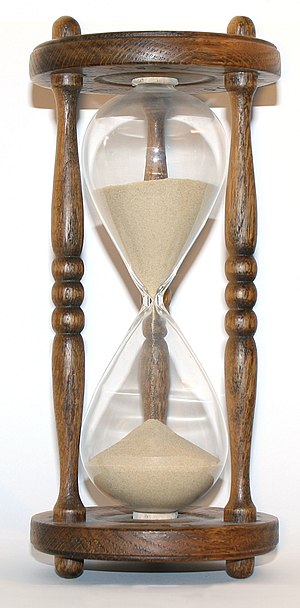Historical Geology/Concepts in absolute dating

In this article I shall define absolute dating, and shall discuss the conditions that we would require to use a geological process as the basis for absolute dating.
Absolute dating defined
[edit | edit source]In the articles on stratigraphy we looked at what is called relative dating, where we could say that one geological feature was older or younger than another but without actually putting dates on them. By contrast, absolute dating allows us to assign dates to geological features.
To avoid confusion later on, let us say at once that the "absolute" in "absolute dating" is not short for "absolutely correct". In this context, the word "absolute" is not the opposite of "approximate" but just of the word "relative". A method of dating which was accurate to within a billion years either way would still technically speaking be a method of absolute dating, it would just be a very bad one.
Conditions for absolute dating
[edit | edit source]Suppose that we wanted to find out how long it has been since an hourglass was set running by measuring the amount of sand in the lower bulb. To do so successfully, we would need to assure ourselves of the following conditions:
- That we can in fact accurately measure the amount of sand in the lower bulb.
- That we know the rate (or rates, if it may have varied) at which the sand has trickled from the upper bulb to the lower.
- That there is no hole in the lower bulb from which sand may have leaked out.
- That there was no sand in the lower bulb when the process started.
- That the process has been uninterrupted, and that since the hourglass was set running it hasn't spent time lying on its side, or standing the other way up.
Given these conditions, we can find out how long the hourglass has been running. If we wish to use a geological process as the geological equivalent of an hourglass, we would want to have similar conditions: we would like to find some quantity which we can measure reliably (corresponding to the condition that we can measure the amount of sand in the lower bulb of the hourglass); which increases or decreases from a known quantity (corresponding to the lower bulb of the hourglass being empty when it starts running) at a known rate (corresponding to knowing the rate of flow of sand); and so forth.
Note that the conditions we have given for the hourglass are ideal conditions which we would require to know exactly how long it is since the hourglass started running. If conditions are less than ideal, we may still be in a position to come up with an approximate figure which is better than nothing. If, for example, we cannot measure precisely the amount of sand in the lower bulb, but we have good reason to think that our estimate of it must be within 10% of the true value, then we also have a good reason to think that we can give the time it's been running to within 10%. Or again, if there may have been sand in the lower bulb when it started running, but we have a good reason to think that there can't have been very much, then we also have a good reason to think that the figure which we get for the time can't be very wrong; and so on.
The geological processes that we'll be discussing work rather like that. We have no reason to believe that nature will be so obliging as to always provide us with the ideal conditions that would provide us with ideal clocks; but by analysis of the geological conditions as they actually are, we can often set limits to how imperfect the geological clocks can be.
For educational purposes, we shall start with a method which barely works at all under any circumstances. This will be the subject of the next article.